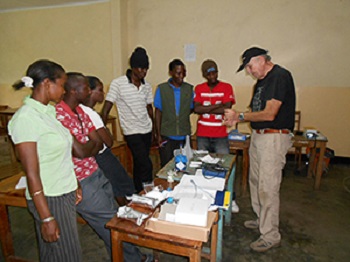Seminar “Clean Drinking Water for Tanzania”
From the 6th to the 16th of January 2013 I travelled together with Gabriele and Dietmar Stuck as part of the fact-finding mission of “Life needs Water” to the districts Kilimanjaro and Tangier in Tanzania. My goal was to explore the health status of drinking water, in order to assess whether my knowledge and experience in chemistry, microbiology and food hygiene could be beneficial.
Based on the fact that in this area of volcanic origin fluorspar is found and hence the fluoride content in the water is extremely high and can be harmful (fluctuations from 2.5 to 26.0 mg fluoride ion per liter of water were identified by the LUA Carinthia), thus it is obvious that the project drinking water for Tanzania needs to be set up on a wider basis, not just to find water but also to promote sustainable good drinking water.
It`s not difficult to pass judgment from a distance on the basis of the media reports and the WHO on the hygienic water situation in Tanzania which is available both to the people in the city and in the country, but does not help.
My intention was to get as part of the project through its own microbiological investigations on the ground a realistic picture and at the same time to train the trainees in the basic concepts of food hygiene. In this case, the particular suitability of individual participants showed.
Three pillar principle:
– Renovate existing wells and build new wells according to the present technology standards. Own well drilling company.
– Control and monitor the use as drinking water. Private service laboratory.
– Coordinate activities with the Water Office and the Ministery of Water.
Own management.
A meeting was held for this purpose in the Water-office in Moshi.
Seminar Participants:
Barnaba J. Sway, Hellena M. Nassari, Rachel F. Mungure, Elirehema Manjecka, Godlisten M.Pallangeco, Alex R. Nnko.
Location: Hai Vocational Training Center/Moshi
Theoretical part:
1) What is hygiene?
2) Types of hygiene (Hospital / Food – Water / Personal hygiene – Personal cleanliness)
Why clean water – for what reason?
No privilege for the rich!
Standard in Austria / EU, Drinking water-VO, Codex,
Tests required – if an appropriate standard= okay,
If there are contaminous germs in the water – carry out a disinfection
3) Water analysis according to drinking water-VO:
Criteria:
– Smell / Taste: description
– conductance: mS/cm
– water temperature: °C
– pH-value
– water hardness: Ca, Mg, Fe
– Heavy metals: Cu, Pb, Cd
– Anions: nitrate, nitrite, chloride, fluoride* (selektive-elektrode)
– germ content: GKA (< 100 KBE/ml), coliform bacteria = indicator organisms (0 KBE/100 ml)
4) General microbiology
– Microbial growth – immune system
– Good or bad germs:
Cholera – Vibrio
Meningo-cocci
Typhus – Salmonella
Tetanus – Clostridium tetani
Hepatitis: Candida – Yeast
Malaria – Viruses
Polio – Viruses
Practical part
1) Preparation for sampling:
Clean environment, clean tasting tap, pre-run water.
2) Chemical analysis: demonstration
The equipment for the chemical water analysis was borrowed from THONHAUSER Ltd, Gießhübel.
An overall chemical analysis of the drinking water was made at 4 different wells. A written certificate was forwarded to Hai Vocational Training Centre.
3) Preparation for the microbiological sampling:
The equipment came from the company Sartorius and was sponsored by the company THONHAUSER. (Value: € 900, -)
Washing hands – the correct way!
Clean overalls
Headgear / hair protection
Water sampling site – Rinse – abflammbieren – take microbiological water sample.
Overall microbiological samples were taken from 4 different wells and processed on site. Incubation was carried out in an insulated thermal bag.
Results
One well in the district of Arusha had 6 coliforms / 100 ml The owner was informed.
All wells had total bacterial counts of 100 CFU / ml of 1, in some cases 10 ³. This amongst other things, is due to an elevated tank made of black plastic, in which the water during the day is additionally heated by solar radiation.
The organoleptic and chemical parameters could be evaluated as acceptable with the proviso that the fluoride content * due to delivery problems of the corresponding kits could not be defined.
The students showed great interest and were involved in the practical demonstrations. To conclude their knowledge was examined in a multiple-choice test.
Thank you Mr. Thonhauser for your valuable contribution!



